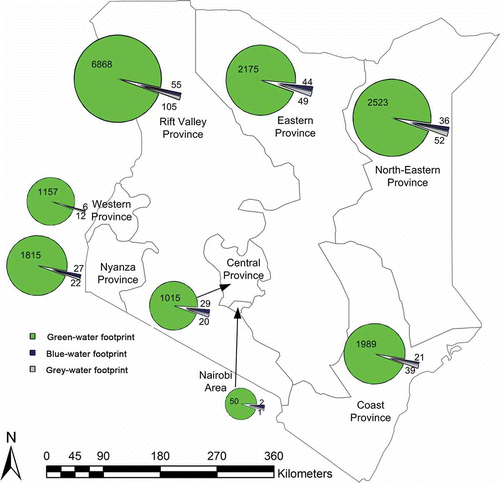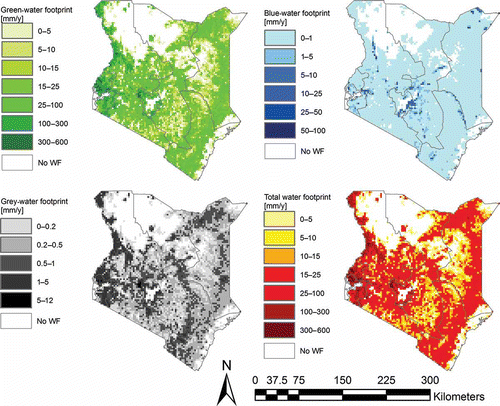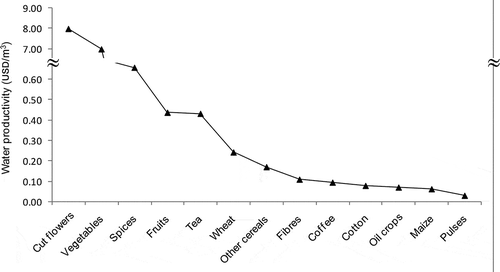Abstract
This study quantifies and maps the water footprint of Kenya from both production and consumption perspectives and estimates the country’s virtual water export and import. Kenya’s virtual water export related to trade in agricultural products was 4.1 km3/y; its virtual water import was 4.0 km3/y. The average export earning per unit of water consumed or polluted in producing agricultural export products was USD 0.25/m3, while the average expenditure on imported commodities per unit of virtual water imported was USD 0.10/m3. In addition to increasing water productivity in crop production, Kenya can mitigate its water scarcity by increasing imports of water-intensive products such as cereals and exports of high-value products such as cut flowers, vegetables, spices and tea.
Introduction
There are great disparities in water use and scarcity within and between countries because both people and water resources are distributed unevenly across the globe. Virtual water import in the form of import of agricultural goods is increasingly recognized as a mechanism to improve national water security (Allan, Citation2003; Chapagain, Hoekstra, & Savenije, Citation2006; De Fraiture, Cai, Amarasinghe, Rosegrant, & Molden, Citation2004; Hoekstra, Citation2003; Konar, Dalin, Hanasaki, Rinaldo, & Rodriguez-Iturbe, Citation2012; Oki & Kanae, Citation2004; Yang, Wang, Abbaspour, & Zehnder, Citation2006). Virtual water import enables nations to save scarce domestic water resources by importing water-intensive products and exporting commodities that require little water. On the other hand, water-abundant countries can profit by exporting water-intensive commodities (Hoekstra & Chapagain, Citation2008).
Kenya’s internal renewable blue-water resources are estimated at 20.7 km3/y (FAO, Citation2005). Most of this, 20.2 km3/y, is available as surface water. Renewable groundwater resources are estimated at 3.5 km3/y, of which 3.0 km3/y overlaps with the annual renewable surface-water resources. It is estimated that 10 km3/y of river water flows into the country (FAO, Citation2005), which means that the total renewable water resources of Kenya are 30.7 km3/y.
According to Wong, Roy, and Duraiappah (Citation2005), the available renewable water resources are insufficient to meet Kenya’s water needs. Kenya is generally characterized as a water-stressed country (FAO, Citation2005; Ohlsson & Appelgren, Citation1998; UNEP, Citation2006). This is also the starting-point of Kenya’s ‘Vision 2030’ (GoK, Citation2007).
The aim of this paper is to assess the relation between national water resources use and international trade in a case study of Kenya. The water footprint of Kenya is quantified and mapped from both production and consumption perspectives for the period 1996–2005. The water footprint related to the production of agricultural export commodities is estimated and put in the context of export earnings. The import side is also considered, by quantifying how much water is embedded in imported commodities.
Previous water footprint and virtual water trade studies range from the global scale (Hoekstra & Chapagain, Citation2008; Hoekstra & Mekonnen, Citation2012; Hoekstra & Chapagain, Citation2007b) to national or sub-national scales. National studies have been carried out for China (Liu & Savenije, Citation2008; Ma, Hoekstra, Wang, Chapagain, & Wang, Citation2006), France (Ercin, Mekonnen, & Hoekstra, Citation2013), Germany (Sonnenberg, Chapagain, Geiger, & August, Citation2009), India (Kampman, Hoekstra, & Krol, Citation2008; Verma, Kampman, van der Zaag, & Hoekstra, Citation2009), Indonesia (Bulsink, Hoekstra, & Booij, Citation2010), Morocco (Hoekstra & Chapagain, Citation2007a), the Netherlands (Hoekstra & Chapagain, Citation2007a; van Oel, Mekonnen, & Hoekstra, Citation2009), Spain (Aldaya et al., Citation2010; Garrido et al., Citation2010) and the UK (Chapagain & Orr, Citation2008). The present study for Kenya differs from earlier studies by assessing the possibilities of water use efficiency improvements at three levels, following the proposal by Hoekstra and Hung (Citation2005): reduction of water footprint per unit of production at the user level; economically efficient allocation of water at the catchment level; and smart virtual water trade at the international level. Furthermore, this study assesses the water footprint and water scarcity within Kenya at a higher spatial resolution than has been used before.
Method and data
The water footprint is an indicator of human appropriation of freshwater resources. The term ‘freshwater appropriation’ refers to both consumptive water use (water evaporated or incorporated into the product) and the water required to assimilate pollutants. The water footprint has three components: the green-, blue- and grey-water footprints. The green-water footprint is the volume of green water (rainwater) consumed. The blue-water footprint refers to consumption of blue-water resources (surface and groundwater). The grey-water footprint is an indicator of the degree of freshwater pollution and is defined as the volume of freshwater required to assimilate the load of pollutants, given existing ambient water quality standards.
Green-, blue- and grey-water footprints were estimated following the calculation framework set out in The Water Footprint Assessment Manual, developed by the Water Footprint Network (Hoekstra, Chapagain, Aldaya, & Mekonnen, Citation2011). The water footprint within a nation is defined as the total freshwater volume consumed or polluted within the territory of the nation as a result of different economic activities. Data on water footprints of crop production in Kenya were taken from Mekonnen and Hoekstra (Citation2011).
The virtual water export from a nation is the sum of virtual water export from domestic water resources and re-exported virtual water of foreign origin. The gross virtual water flow is calculated by multiplying the volume of trade by the water footprint per tonne of product as in the exporting nation. We take the average product water footprint as in the exporting country, and when a product is imported from a country that does not produce the product we assume the global average product water footprint for that import flow. Kenya’s virtual water import and export related to trade in agricultural products was taken from Hoekstra and Mekonnen (Citation2012).
The water footprint of national consumption is defined as the total volume of freshwater that is used to produce the goods and services consumed by the inhabitants of the nation. It consists of an internal and external component. The internal water footprint of national consumption refers to the use of domestic water resources to produce goods and services consumed by the national population. It is the difference between the water footprint within the nation and the volume of virtual water export to other nations related to export of products produced with domestic water resources. The external water footprint of national consumption, on the other hand, is defined as the volume of water resources used in other nations to produce goods and services consumed by the population in the nation considered. It is the difference between the virtual water import into the nation and the volume of virtual water re-exported to other nations as a result of re-export of imported products.
The water footprint of national consumption is calculated by adding the direct and indirect water footprints of consumers within the nation. The direct water footprint of consumers refers to consumption and pollution of water related to domestic water supply. The indirect water footprint of consumers refers to the water use by others to make the commodities consumed, where we distinguish between agricultural and industrial commodities. The water footprint of national consumption of agricultural and industrial commodities can be calculated through either the top-down or the bottom-up approach (Hoekstra et al., Citation2011). In the top-down approach, the water footprint of national consumption is calculated as the water footprint within the nation plus the virtual water import minus the virtual water export. In the bottom-up approach, the water footprint of national consumption is calculated by adding the direct and indirect water footprints of consumers within the nation. The water footprint of national consumption used here was taken from Hoekstra and Mekonnen (Citation2012), who used the bottom-up approach.
Water productivities of crops were calculated per crop, at national level, by dividing the crop value (USD/kg) by the water footprint of the crop (m3/kg). Data on export and import values of agricultural products were taken from the Statistics for International Trade Analysis database, available from the International Trade Centre (ITC, Citation2007).
Results
Water footprint of crop production
The total water footprint related to crop production in Kenya for 1996–2005 was 18.1 km3/y (97% green, 1% blue and 2% grey). The largest share (38%) of this water footprint was due to the production of maize. Dry beans, coffee, tea and wheat together contributed 33% ().
Table 1. The water footprint of crop production in Kenya (1996–2005).
About 61% of the green-water footprint was due to the production of maize, dry beans and coffee. The largest blue-water footprints were estimated for growing coffee (51 million m3/y) and rice (35 million m3/y), which together accounted for 40% of the total blue-water footprint related to crop production.
Although its fertilizer application rates are relatively low by international standards, Kenya has among the highest fertilizer application rates within Sub-Saharan Africa, excluding South Africa. Fertilizer use has grown in the recent past and reached over 350,000 metric tonnes in 2004-05 (Ariga, Jayne, & Nyoro, Citation2006). Not all fertilizer applied will be absorbed by the plant. A significant amount of nitrogen can remain in the soil, and some of this will eventually leach into the groundwater or run off into surface water, causing pollution. We estimate that the grey-water footprint due to nitrogen fertilizer leaching from crop fields was about 300 million m3/y over the period 1996–2005. A little over half of this was related to the production of three crops: maize, coffee and potato.
About 23% of the agricultural water footprint was due to producing export products. The remaining 77% of the water was used for producing products for domestic consumption. It is worth noting that the average foreign currency earnings per unit of water consumed or polluted in producing agricultural export products were high (see for the economic water productivity of crops).
Among the major crops, the water footprint per tonne of crop increases from sugar-cane (roughly 100 m3/t), through potato (~400 m3/t) and maize, (~2700 m3/t) to coffee (~24000 m3/t). The largest blue- and grey-water footprints per tonne of crop were calculated for coffee (). The water footprint per tonne of crop varies significantly across the country, as shown in . While the total water footprint related to crop production is high in western Kenya, water footprints per tonne of crop are highest in northern and eastern Kenya. The water footprint of maize, for example, varies from 1200 m3/t in some parts of the Rift Valley and western provinces to as high as 6000 m3/t in the Eastern Province. This variation can be partly explained by differences in climatic conditions. The northern and eastern regions of Kenya are arid or semi-arid, with annual precipitation as low as 200 mm, which affects crop yields.
Figure 1. Green, blue, grey and total water footprint per tonne of maize (top) and coffee (bottom), 1996–2005.

The total water footprint of crop production in each province of Kenya is shown in . Rift Valley Province accounts for about 39% of the total water footprint related to crop production. The largest blue-water footprints are found in Rift Valley (25%) and Nyanza (20%) Provinces. Rift Valley Province alone accounts for 35% of the grey-water footprint. Since most of Kenya’s farming relies on rainfall, the croplands are concentrated in the places where rainfall is most reliable, such as the highlands, the Lake Victoria basin, and the narrow coastal strip. The green-water footprint dominates (>95%) in all provinces, reaching up to 98% in Rift Valley and Western Provinces. shows the variation in the green, blue, grey and total water footprint of crop production within the country on a 5-by-5-arcminute grid. The pattern of the total water footprint is similar to the pattern of harvested crop area (Monfreda, Ramankutty, & Foley, Citation2008), which indicates that the water footprint per grid cell is largely determined by the fraction of harvested crop area per grid cell.
Virtual water flows related to trade in agricultural products
In the period 1996–2005, Kenya’s virtual water export related to agricultural products was 4.1 km3/y (95% green, 3% blue and 2% grey). About 65% was related to exports of coffee and tea. Cotton products, livestock products and products of oil crops were the other agricultural products responsible for significant virtual water export from Kenya (). Kenya’s total export earnings related to agricultural exports were USD 1.02 billion. Given these export earnings and the associated water use, we calculate earnings of about USD 0.25/m3.
Table 2. Kenya’s virtual water export by agricultural product, export earnings and water productivity (1996–2005).
Cut flowers generated the highest economic returns per unit of water exported, followed by vegetable products. The major destinations for Kenya’s virtual water exports were the US, Germany, the UK and Pakistan, which together accounted for about 45% of Kenya’s virtual water exports.
In the period 1996–2005, the virtual water exported in relation to exports of coffee and tea was 2.6 km3/y (96% green, 2% blue and 2% grey). The main coffee-growing regions include the region north of Nairobi, the high plateau surrounding Mount Kenya, and the Aberdare region. Tea-growing regions in Kenya are located in the Great Rift Valley. To the east of the Rift Valley are the Aberdare Highlands (Mt. Kenya and the Nyabene Hills). To the west of the Rift Valley are the Nandi Hills and the highlands around Kericho, Mt. Elgon and the Kisii Highlands. The rainfall in these regions ranges from 1200 mm to 2700 mm annually (EPZA, Citation2005). The water footprint for both coffee and tea is predominantly green water (96%). The contribution of coffee and tea towards Kenya’s socio-economic development is vital. Coffee and tea cultivation provides direct and indirect employment to a large proportion of the population. In addition, the combined annual export revenues from coffee and tea accounted for USD 581 million, a 57% share in the total revenue generated from exports of the selected crops and livestock products in 1996–2005.
Kenya’s horticulture industry (vegetables, fruits and cut flowers) is the fastest-growing agricultural subsector and has become the second-largest export earner after tea, contributing 13% to the total export value in 1996–2005. Cut-flowers export alone accounted for about 53% of Kenyan horticultural export value, and its overall contribution to the country’s export earnings is growing rapidly. In 1996–2005, the virtual water export in relation to the export of cut flowers was 18 million m3/y (22% green, 45% blue and 33% grey). The virtual water export in relation to the export of cut flowers has grown significantly, from 14 million m3/y in 1996 to 27 million m3/y in 2005. Over 90% of this went to just three countries: the Netherlands (69%), the UK (18%) and Germany (7%) (Mekonnen, Hoekstra, & Becht, Citation2012).
The import, in the study period, of virtual water to Kenya related to the import of agricultural goods was 4.0 km3/y, about the same as virtual water export (). The virtual water trade balance of the country was approximately zero, but the monetary trade balance was positive: the export value of the exported agricultural commodities was 2.5 times the total cost of the imported agricultural commodities. The total value of the agricultural products imported by Kenya was USD 412 million/y. The average cost of imported commodities per unit of virtual water imported was USD 0.10/m3. Thus, on average, Kenya received USD 0.25/m3 for exported water and paid USD 0.10/m3 for imported water.
Table 3. Kenya’s virtual water import and import expenditure related to import of agricultural products (1996–2005).
Imports of cereal products (mainly from Pakistan and South Africa) and palm-oil products (mainly from Indonesia and Singapore) were responsible for 2.0 km3/y and 1.1 km3/y, respectively (). Other key agricultural products responsible for Kenya’s virtual water import were sugar products (0.21 km3/y) and cotton products (0.21 km3/y). Kenya is not self-sufficient in water for its own food supply: 10% of its maize (the major staple food), 63% of its wheat and 72% of its rice are imported. Although the level of domestic cereal production has remained high, imports have shown significant growth. In 1996–2005, the share of imports was significant, reaching over 25% of the total supply of the main cereal products (maize, rice and wheat). At the same time, Kenya’s exports of coffee and tea have enjoyed significant growth (). This is evidence of a shift in the agricultural sector towards the export of high-value crops (tea, coffee and horticulture) and import of low-value crops such as cereals.
Figure 4. Global map showing countries with net virtual water import because of agricultural products imported from Kenya (green areas, ![]()
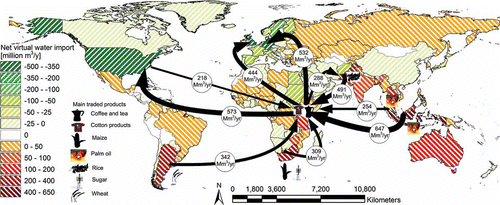
Figure 5. Kenya’s production and import of cereals (maize, rice and wheat) and export of coffee and tea. Data source: FAO (Citation2010).

The water footprint of national consumption
In the period 1996–2005, the total water footprint related to Kenyan consumption of agricultural products was 34.5 km3/y, equivalent to 1080 m3/y per capita (). When we include the water footprint related to the consumption of industrial products and domestic water, we find a total water footprint for Kenyan consumption of 35.2 km3/y, which means that Kenyan citizens had a water footprint of 1100 m3/y per capita on average (94% green, 3% blue and 3% grey). This is 20% less than the global average (Hoekstra & Mekonnen, Citation2012).
Table 4. The water footprint of Kenyan national consumption.
The water footprint of Kenyan consumption is largely determined by the consumption of agricultural goods, contributing 98% to the total water footprint. When we look at the level of product categories, consumption of meat products gives the largest contribution to the total water footprint (30%), followed by cereal products (29%) and pulses (12%). The consumption of maize products contributes the largest proportion (74%) to the cereal-related water footprint of Kenyan consumers, which is no surprise given the fact that Kenya’s food staple is ugali, made from cornmeal.
When we look at the breakdown of the water footprint into internal and external, the external water footprint constitutes 17% of the total water footprint, a bit lower than the global average of 22% (Hoekstra & Mekonnen, Citation2012).
Water conservation in Kenya – the role of virtual water trade
Water scarcity is an increasingly significant problem for Kenya (GoK, Citation2007; UNEP, Citation2006). Kenya’s total renewable blue-water resources are estimated at 30.7 km3/y (FAO, Citation2005). Using the 2005 population of 35.6 million (UNSD, Citation2010), this comes down to 862 m3/y per capita. According to the UN’s medium-variant projection, Kenya’s population will grow towards 97 million in the year 2050 and on to 160 million in 2100 (UN, Citation2011). This means that the renewable blue-water resources will drop towards 316 m3 per capita in 2050 and 192 m3 per capita in 2100. This is extremely little when compared with the roughly 1000 m3/y per capita needed for an adequate diet and often used as a threshold for chronic water shortage (Falkenmark, Rockström, & Karlberg, Citation2009). One should realize, though, that Kenya mainly draws on green-water resources (rain-fed agriculture). Even in irrigated agriculture, green-water resources are an important component in the total water supply. Much of the world’s food is grown not from blue but from green water (Falkenmark & Rockström, Citation2004). This is certainly the case in Kenya, where agriculture is mainly rainfed and about 97% of the water footprint related to crop production is a green-water footprint. Therefore, it is quite important to consider the level of green-water scarcity as well.
The average annual rainfall in Kenya is approximately 630 mm. There is significant variation across the country, from less than 200 mm in northern Kenya to over 1800 mm on the slopes of Mt. Kenya (FAO, Citation2005). More than 80% of the country, including the northern and eastern regions, is arid or semi-arid, and only 17% is considered to have high agricultural potential (FAO, Citation2005; WRI, Citation2007). The annual rainfall figure does not reveal the existing pattern of dry and wet seasons within the year, the differences between drier and wetter years, or the variations across the country. shows the temporal and spatial variability of Kenya’s rainfall, with long-term statistics for the months of February, April and July, and for the annual average. East of the Rift Valley, ‘long’ rains fall from March to May and ‘short’ rains from October to November (WRI, Citation2007). The western part of the country, bordering Lake Victoria, generally experiences only one long rainy season, from March to September. For most of the country, the ‘long’ rains account for much of the annual rainfall, but the ‘short’ rains also play a crucial role in many areas (WRI, Citation2007). There is also great variation in the rainfall amount and the distribution from year to year ().
Figure 6. Temporal and spatial rainfall variability in Kenya. Data source: WRI (Citation2007).
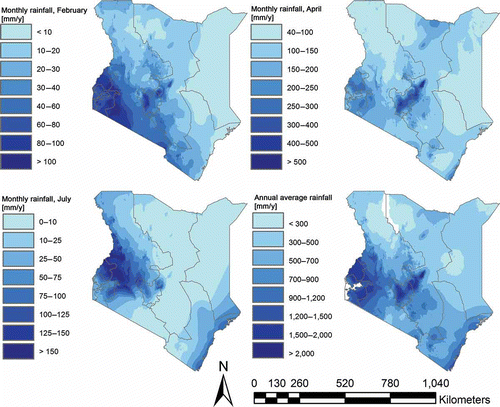
Figure 7. Kenya’s year-to-year rainfall variability. Adopted from Mogaka, Gichere, Davis, and Hirji (Citation2006).
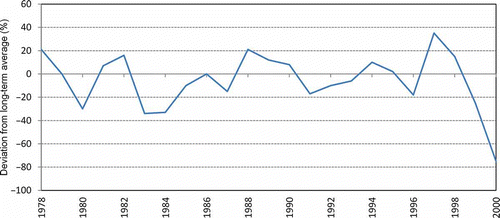
The temporal and spatial variability of rainfall, combined with the high crop water requirements typical in the semi-arid and arid parts of the country, precludes much of the country from being suitable for the growth of rainfed crops. Thus, policy makers should take effective measures to use the limited water resources wisely, in order to avoid future problems with the country’s food production and economic development.
Managing water scarcity entails either supply-side or demand-side management or a combination of the two. Since the available water supply is limited in many areas and increasing it is usually costly or simply impossible, there is a growing emphasis on increasing water-use efficiency (Falkenmark et al., Citation2007; Gleick, Citation1998; Postel, Citation2000; Wallace & Gregory, Citation2002). According to Hoekstra and Hung (Citation2005), there are three levels at which water use efficiency can be increased: the level of the water user; the level at which water allocation takes place (usually the catchment level); and the international level, at which virtual water trade takes place.
At the user level, water-use efficiency can be increased by enlarging water productivity (more crop per drop), both in rainfed and irrigated agriculture. Green-water productivity can often be increased by better soil management, so that the soil better holds rainwater, which improves water availability to the plants and thus helps to increase yields. One could also look at the possibilities of introducing high-yielding and drought-resistant crops, and smart ways of crop rotation. The key here is to reduce unproductive evaporation and increase yields. Blue-water productivity can be increased by better irrigation technology and practices (e.g. deficit irrigation). Indirect instruments to stimulate farmers to increase blue-water productivity are charging water prices based on full marginal cost, assisting with making necessary investments and creating awareness of the detrimental impacts of excessive water abstraction.
Most of Kenya’s irrigation systems suffer from poor irrigation efficiency. About 60% of the irrigated land is irrigated by sprinklers and about 38% by surface irrigation (FAO, Citation2005). Although the potential for water saving through increased efficiency is high, it is not as large as one may think. This is because the classical definition of irrigation efficiency ignores the value of return flows, i.e. irrigation-water runoff and seepage that re-enter the surface–groundwater system (Keller & Keller, Citation1995; Seckler, Molden, & Sakthivadivel, Citation2003). When the return flow is reused, overall efficiency increases. Thus, while individual systems could have low levels of efficiency, the basin-wide efficiencies can be much higher. Therefore, taking steps to increase water-use efficiency at the local level based on the classical efficiency calculations often will not result in genuine water savings. The key to blue-water footprint reduction is to reduce unproductive evaporation losses and increase yields.
shows that the maize yield in Kenya has shown no improvement over the years. Although it is slightly above the African average, it is far below the yields obtained in Egypt and South Africa and the average yield at the global level. This low yield is an indication that there is still much room for improvement in Kenya’s agriculture productivity.
Figure 8. Kenya’s maize yield compared to maize yields in Egypt, South Africa, the continent of Africa and the world. Data source: FAO (Citation2010).
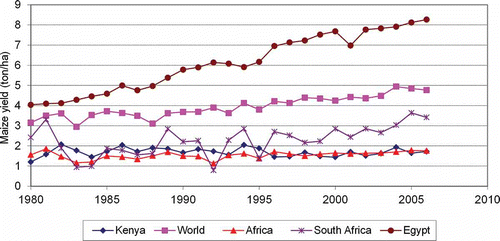
At the catchment level, water-use efficiency can be improved by reallocating the limited water resources to those purposes with the highest marginal benefits. At this level, we speak of ‘allocative efficiency’ (Allan Citation1999; Dinar, Citation1998). shows the economic water productivity of selected crops in Kenya. Cut flowers have the highest productivity per unit of water – 250 times that of pulses and 120 times that of maize. Vegetables have high water productivity as well, close to that of cut flowers. Spices, fruits and tea also produce more value per unit of water, compared to most other crops. This analysis is consistent with results obtained by other researchers. Owuor (Citation1998), for example, showed that horticultural crops are more productive than cereal crops such as maize. The high productivity in the cut-flower and vegetable sectors is partly due to irrigation, so the blue-water footprint is relatively large here. This is a concern in the sense that blue-water resources in Kenya are much scarcer than green-water resources.
At the international level, water-use efficiency can be increased if nations use their relative water abundance or scarcity to either encourage or discourage the use of domestic water resources in producing export commodities (Hoekstra & Chapagain, Citation2008). In the case of Kenya, this implies that the country could best seek to achieve a positive net virtual water import balance. It does not mean that it should stop using domestic water resources in producing export products, but that it should do so wisely, to make sure that only those crops are produced for export that generate a high value per drop of water used and to find a balance between production for export and production for domestic food security. Kenya’s current virtual water export is based mainly on high-value crops such as coffee, tea and horticultural crops, which indeed generate a high return per unit of water consumed – higher than cereal crops like maize. Kenya’s imports, on the other hand, are mainly low-value but water-intensive cereal products. The net effect of Kenya’s virtual water exports and imports related to agricultural trade is more or less neutral.
Nyoro, Wanzala, and Awour (Citation2001) showed that Kenya is less competitive compared to its neighbours, Uganda and Tanzania, in producing the major cereal crops, in particular maize. The local production cost of maize, sugar and (in some cases) wheat is much higher than the import parity price. According to Nyoro et al. (Citation2001), the production cost of coffee is among the highest in the world. Under such conditions, a rational economic decision would be to produce and export crops in which the country has a comparative economic advantage and import crops where its comparative advantage is minimal or negative. However, such policy decisions are never straightforward. They require a policy shift from national food self-sufficiency to food security. Such a policy presupposes a strong and diversified economy, which provides enough income to pay for the virtual water import in a sustainable manner. Unless there are enough foreign currency earnings from the export of high-productivity crops, from the industry and the service sectors, virtual water import may result in the depletion of the country’s foreign currency reserve. In addition, the domestic agricultural sector needs to become more competitive; otherwise it will be damaged through the availability of cheaper agricultural goods from outside the country. The other important factor that must be addressed is the maintenance of employment for the rural population. In a country such as Kenya, where the great majority of the population relies on the agricultural sector for their livelihood, a policy shift in the direction of virtual water import may create great social stress (Allan Citation1999; Turton & Ohlsson, Citation1999). Thus, a careful analysis of all available options for water management must be made before embracing virtual water trade as a strategy.
Conclusion
In the period 1996–2005, Kenya’s imports contributed 25% to its total supply of the main cereals (maize, wheat and rice). In this way, Kenya is relying significantly on freshwater resources elsewhere. On the other hand, a substantial part (23%) of the freshwater appropriation in Kenya is used in producing exported products. About 42% of Kenya’s total foreign exchange earnings come from the export of coffee, tea and horticultural products. These products contributed about 66% toward the virtual water export related to export of agricultural commodities. Currently, the water use within Kenya for producing export products is more or less in balance with the water use elsewhere for making products for consumption in Kenya. However, given Kenya’s growing population, the increase in the use of scarce water resource for export products may, in the long run, conflict with water use for domestic food supply. The dilemma will be to increase water use for high-value export commodities in order to be able to import more food, or to reserve increasing amounts of water resources for domestic food production at the cost of water for producing export products. As long as water productivity can be increased (producing more with the same water), making this trade-off between water for export versus water for domestic consumption can be postponed; but the moment will inevitably come, because of Kenya’s growing population and changing consumption patterns (more animal products, which are more water-intensive per kcal than crop products).
The production and export of cash crops from Kenya positively impacts on the socio-economic development of the country. The water use for coffee and tea production is mainly positive: the impacts on the water system are limited because water use mostly involves the use of rainwater, while the export revenues amount to USD 581 million per year, which is 29% of Kenya’s total export value. The water use for cut-flower production near Lake Naivasha contributes to water scarcity (declining lake level) and pollution problems, but the cut-flower export sector is a vital one, contributing USD 141 million per year in foreign currency, which is 7% of Kenya’s export value.
In order to address its water-scarcity problem, Kenya must implement policy measures at different levels. Such policy measures include: improving water-use efficiency at the user level by charging prices based on full marginal cost; stimulating water-saving technologies; and creating awareness among water users of the detrimental impacts of excessive water abstraction. Charging prices on full marginal cost, besides its positive effect on raising water-use efficiency, will force farmers to reallocate the limited water to crops which can generate high economic returns per unit of water. Kenya’s crop yields are among the lowest in the world. Raising yields by growing selected seeds and utilizing the available soil moisture through integrated soil and water management will be essential. At the river-basin level, water-use efficiency can be improved by reallocating water to those purposes with the highest marginal benefits. Finally, Kenya can use virtual water import and export as a strategy to address its water problem by discouraging the use of domestic water resources in producing export commodities that are highly water-intensive and have low economic returns per unit of water. Production of cash crops with high economic returns per unit of water that are less water-intensive and produced from rainwater can be encouraged, although Kenya’s challenge will be to maintain national food security at the same time.
References
- Aldaya, M. M., Garrido, A., Llamas, M. R., Varela-Ortega, C., Novo, P., & Casado, R. R. (2010). Water footrpint and virtual water trade in Spain. In A. Garrido & M. R. Llamas (Eds.), Water policy in Spain (pp. 49–59). Leiden, The Netherlands: CRC Press.
- Allan, T. (1999). Productive efficiency and allocative efficiency: Why better water management may not solve the problem. Agricultural Water Management, 40(1), 71–75. doi:10.1016/S0378-3774(98)00106-1
- Allan, J. A. (2003). Virtual water - the water, food, and trade nexus. Useful concept or misleading metaphor? Water International, 28(1), 106–113. doi:10.1080/02508060.2003.9724812
- Ariga, J., Jayne, T. S., & Nyoro, J. (2006). Factors driving the growth in fertilizer consumption in Kenya, 1990-2005: Sustaining the momentum in Kenya and lessons for broader replicability in Sub-Saharan Africa. Tegemeo Working Paper 24 No. 24, Nairobi, Kenay. Tegemeo Institute of Agricultural Policy and Development, Egerton University.
- Bulsink, F., Hoekstra, A. Y., & Booij, M. J. (2010). The water footprint of Indonesian provinces related to the consumption of crop products. Hydrology and Earth System Sciences, 14(1), 119–128. doi:10.5194/hess-14-119-2010
- Chapagain, A. K., Hoekstra, A. Y., & Savenije, H. H. G. (2006). Water saving through international trade of agricultural products. Hydrology and Earth System Sciences, 10(3), 455–468. doi:10.5194/hess-10-455-2006
- Chapagain, A. K., & Orr, S. (2008). UK Water Footprint: The impact of the UK’s food and fibre consumption on global water resources. Godalming, UK: WWF-UK.
- De Fraiture, C., Cai, X., Amarasinghe, U., Rosegrant, M., & Molden, D. (2004). Does international cereal trade save water? The impact of virtual water trade on global water use. Comprehensive Assessment Research Report, Colombo, Sri Lanka. IWMI.
- Dinar, A. (1998). Water policy reforms: Information needs and implementation obstacles. Water Policy, 1(4), 367–382. doi:10.1016/S1366-7017(99)00005-7
- EPZA. (2005). Tea and coffee industry in Kenya. Nairobi, Kenya: Export Processing Zones Authority.
- Ercin, A. E., Mekonnen, M. M., & Hoekstra, A. Y. (2013). Sustainability of national consumption from a water resources perspective: The case study for France. Ecological Economics, 88, 133–147. doi:10.1016/j.ecolecon.2013.01.015
- Falkenmark, M., Berntell, A., Jägerskog, A., Lundqvist, J., Matz, M., & Tropp, H. (2007). On the verge of a new water scarcity: A call for good governance and human ingenuity SIWI Policy Brief. Stockholm, Sweden: Stockholm International Water Institute.
- Falkenmark, M., & Rockström, J. (2004). Balancing water for humans and nature: The new approach in ecohydrology. London, UK: Earthscan.
- Falkenmark, M., Rockström, J., & Karlberg, L. (2009). Present and future water requirements for feeding humanity. Food Security, 1(1), 59–69. doi:10.1007/s12571-008-0003-x
- FAO (2005). Irrigation in Africa in figures, AQUASTAT Survey 2005. FAO Water Reports No. 29, Rome, Italy. Food and Agriculture Organization.
- FAO (2010). FAOSTAT on-line database. Rome, Italy, Food and Agriculture Organization, Retrived from http://faostat.fao.org (Last accessed: 4 March 2010).
- Garrido, A., Llamas, M. R., Varela-Ortega, C., Novo, P., Rodriguez-Casado, R., & Aldaya, M. M. (2010). Water Footprint and virtual water trade in Spain. New York, USA: Springer.
- Gleick, P. H. (1998). Water in crisis: Paths to sustainable water use. Ecological Applications, 8(3), 571–579. doi:10.1890/1051-0761(1998)008[0571:WICPTS]2.0.CO;2
- GoK. (2007). Vision 2030: A competitive and prosperous Kenya. Nairobi, Kenya: Government of the Republic of Kenya.
- Hoekstra, A. Y. (2003). Virtual water trade: Proceedings of the International Expert Meeting on Virtual Water Trade, Delft, the Netherlands, 12–13 December 2002. Value of Water Research Report Series No. 12, Delft, the Netherlands. UNESCO-IHE.
- Hoekstra, A. Y., & Chapagain, A. K. (2007a). The water footprints of Morocco and the Netherlands: Global water use as a result of domestic consumption of agricultural commodities. Ecological Economics, 64, 143–151. doi:10.1016/j.ecolecon.2007.02.023
- Hoekstra, A. Y., & Chapagain, A. K. (2007b). Water footprints of nations: Water use by people as a function of their consumption pattern. Water Resources Management, 21(1), 35–48. doi:10.1007/s11269-006-9039-x
- Hoekstra, A. Y., & Chapagain, A. K. (2008). Globalization of water: Sharing the planet’s freshwater resources. Oxford, UK: Blackwell.
- Hoekstra, A. Y., Chapagain, A. K., Aldaya, M. M., & Mekonnen, M. M. (2011). The water footprint assessment manual: Setting the global standard. London, UK: Earthscan.
- Hoekstra, A. Y., & Hung, P. Q. (2005). Globalisation of water resources: International virtual water flows in relation to crop trade. Global Environmental Change Part A, 15(1), 45–56. doi:10.1016/j.gloenvcha.2004.06.004
- Hoekstra, A. Y., & Mekonnen, M. M. (2012). The water footprint of humanity. Proceedings of the National Academy of Sciences, 109(9), 3232–3237. doi:10.1073/pnas.1109936109
- ITC. (2007). SITA version 1996–2005 in SITC, [DVD-ROM). Geneva, Switzerland: International Trade Centre.
- Kampman, D. A., Hoekstra, A. Y., & Krol, M. S. (2008). The water footprint of India Value of Water Research Report Series No. 32, Delft, the Netherlands. UNESCO-IHE.
- Keller, A. A., & Keller, J. (1995). Effective Efficiency: A Water Use Efficiency Concept for Allocating Freshwater Resources. Discussion Paper No. 22, Arlington, USA. Centre for Economic Policy Studies, Winrock International.
- Konar, M., Dalin, C., Hanasaki, N., Rinaldo, A., & Rodriguez-Iturbe, I. (2012). Temporal dynamics of blue and green virtual water trade networks. Water Resources Research, 48(7), W07509. doi:10.1029/2012WR011959
- Liu, J., & Savenije, H. H. G. (2008). Food consumption patterns and their effect on water requirement in China. Hydrology Earth System Sciences, 12(3), 887–898. doi:10.5194/hess-12-887-2008
- Ma, J., Hoekstra, A. Y., Wang, H., Chapagain, A. K., & Wang, D. (2006). Virtual versus real water transfers within China. Philosophical Transactions of the Royal Society B-Biological Sciences, 361(1469), 835–842. doi:10.1098/rstb.2005.1644
- Mekonnen, M. M., & Hoekstra, A. Y. (2011). The green, blue and grey water footprint of crops and derived crop products. Hydrology and Earth System Sciences, 15(5), 1577–1600. doi:10.5194/hess-15-1577-2011
- Mekonnen, M., Hoekstra, A., & Becht, R. (2012). Mitigating the water footprint of export cut flowers from the Lake Naivasha Basin, Kenya. Water Resources Management, 26(13), 3725–3742. doi:10.1007/s11269-012-0099-9
- Mogaka, H., Gichere, S., Davis, R., & Hirji, R. (2006). Climate variability and water resources degradation in Kenya: Improving water resources development and management. World Bank Working Paper No. 69, Washington, D.C., USA. World Bank.
- Monfreda, C., Ramankutty, N., & Foley, J. A. (2008). Farming the planet: 2. Geographic distribution of crop areas, yields, physiological types, and net primary production in the year 2000. Global Biogeochemical Cycles, 22(1), GB1022. doi:10.1029/2007GB002947
- Nyoro, J. K., Wanzala, M., & Awour, T. (2001). Increasing Kenya’s agricultural competitiveness: farm level issues. Tegemeo Working Paper No. 4, Nairobi, Kenya. Tegemeo Institute of Agricultural Policy and Development. Egerton University.
- Ohlsson, L., & Appelgren, B. (1998). Water and social resource scarcity: Alternative socially based approaches to assessment and management of water scarcity. The Water Page, Retrived from http://www.africanwater.org/SoicalResourceScarcity.htm, (Last accessed: 1 April 2010).
- Oki, T., & Kanae, S. (2004). Virtual water trade and world water resources. Water Science and Technology, 49(7), 203–209.
- Owuor, P. O. (1998). Determinants of agricultural productivity in Kenya. Kenya Agricultural Marketing and Policy Analysis Project. Nairobi, Kenya & Michigan, USA. Tegemeo Institute of Agricultural Policy and Development, Egerton University & Agricultural Research Institute, Michigan State University.
- Postel, S. L. (2000). Entering an era of water scarcity: The challenges ahead. Ecological Applications, 10(4), 941–948. doi:10.1890/1051-0761(2000)010[0941:EAEOWS]2.0.CO;2
- Seckler, D., Molden, D., & Sakthivadivel, R. (2003). The concept of efficiency in water resources management and policy. In J. W. Kijne, R. Barker & D. Molden (Eds.), Water productivity in agriculture: Limits and opportunities for improvement (pp. 37–51). Wallingford, UK: CAB International.
- Sonnenberg, A., Chapagain, A., Geiger, M., & August, D. (2009). Der Wasser-Fußabdruck Deutschlands: Woher stammt das Wasser, das in unseren Lebensmitteln steckt? Frankfurt, Germany: WWF Deutschland.
- Turton, A. R., & Ohlsson, L. (1999).Water scarcity and social stability: towards a deeper understanding of the key concepts needed to manage water scarcity in developing countries. 9th Stockholm Water SymposiumStockholm, Sweden.
- UN. (2011). World population prospects: The 2010 revision. New York, NY: Population Division, Department of Economic and Social Affairs, United Nations.
- UNEP. (2006). Africa environment outlook-2: Our environment, our wealth. Nairobi, Kenya: United Nations Environment Programme.
- UNSD (2010). Nationals accounts main aggregates database. UN Statistic Division, Retrived from http://unstats.un.org/unsd/snaama/selectionbasicFast.asp, (Last accessed: 20 May 2010).
- van Oel, P. R., Mekonnen, M. M., & Hoekstra, A. Y. (2009). The external water footprint of the Netherlands: Geographically-explicit quantification and impact assessment. Ecological Economics, 69(1), 82–92. doi:10.1016/j.ecolecon.2009.07.014
- Verma, S., Kampman, D. A., van der Zaag, P., & Hoekstra, A. Y. (2009). Going against the flow: A critical analysis of inter-state virtual water trade in the context of India’s National River Linking Program. Physics and Chemistry of the Earth, Parts A/B/C, 34(4–5), 261–269. doi:10.1016/j.pce.2008.05.002
- Wallace, J. S., & Gregory, P. J. (2002). Water resources and their use in food production systems. Aquatic Sciences, 64(4), 363–375. doi:10.1007/PL00012592
- Wong, C., Roy, M., & Duraiappah, A. K. (2005). Connecting poverty and ecosystem services: A series of seven country scoping studies, focuses on Kenya Nairobi. Kenya: UNEP and IISD.
- WRI. (2007). Nature’s benefits in Kenya: An atlas of ecosystems and human well-being. Washington, D.C. USA: World Resources Institute.
- Yang, H., Wang, L., Abbaspour, K. C., & Zehnder, J. B. (2006). Virtual water trade: An assessment of water use efficiency in the international food trade. Hydrology and Earth System Sciences, 10, 443–454. doi:10.5194/hess-10-443-2006

